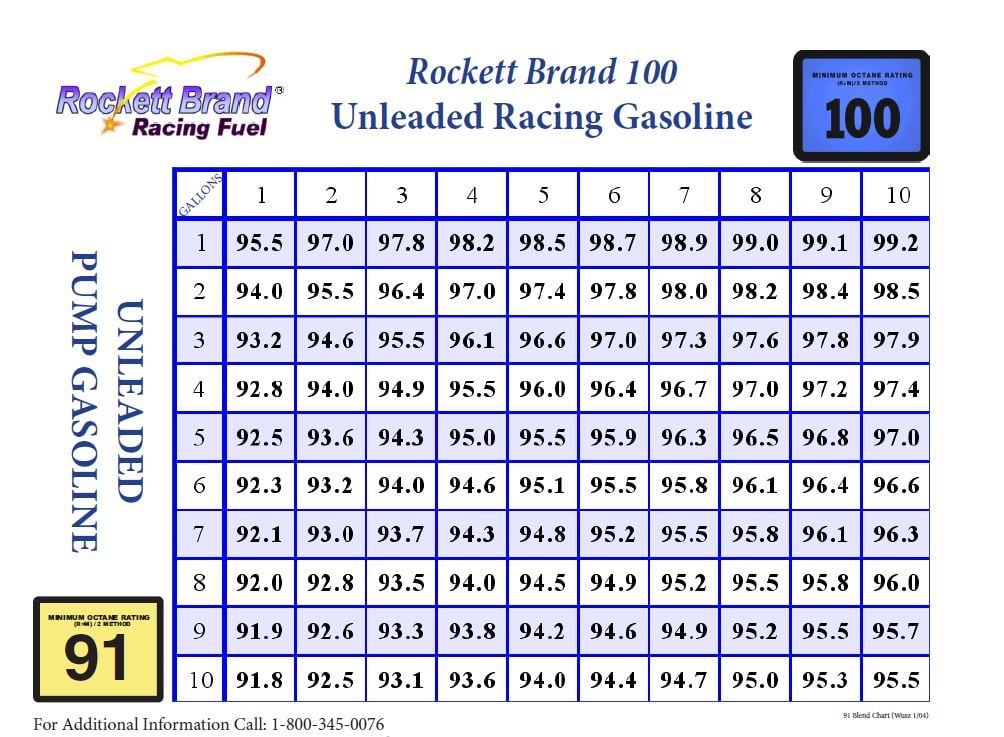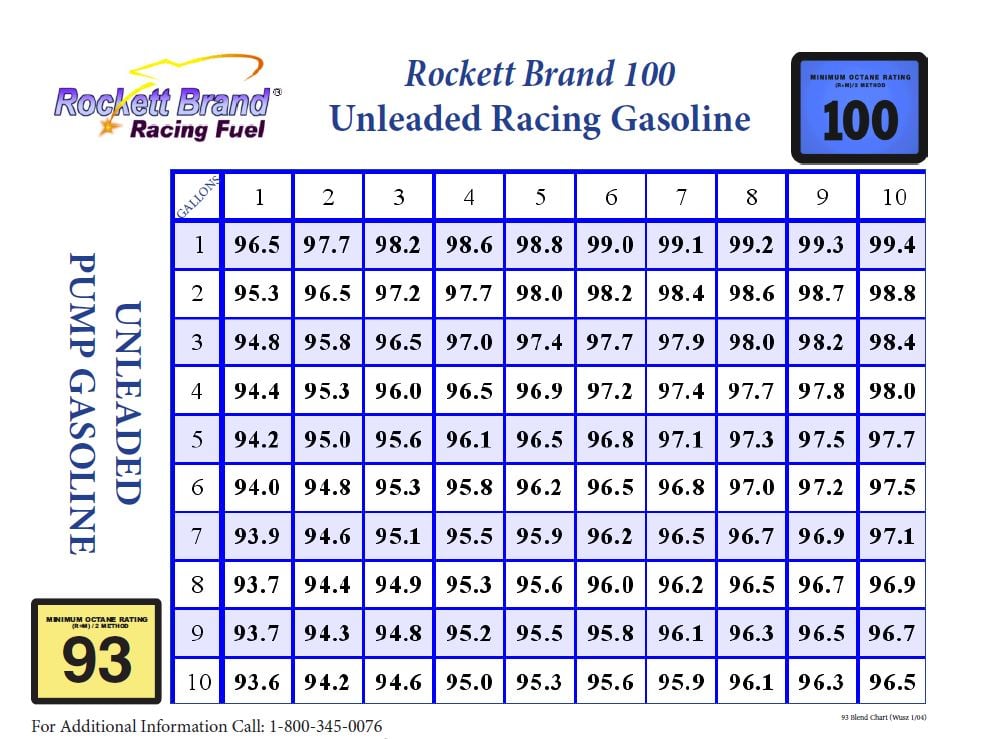
Horsepower comes from engines with the right mix of cylinder pressure combined with the right octane fuel. If too low an octane fuel is used, the engine can detonate. Conversely, too much octane, and power remains high, but the cost is higher with no performance gain. The trick is knowing the right mix.
Words By Jeff Smith/Photos By Jeff Smith and Rockett Brand Racing Fuel
This is the Golden Age of horsepower. Never has it been so easy to make big power numbers. Even truck engines now make more than 400 hp. That power comes from cylinder pressure pushing down harder on those pistons to spin the crank. As cylinder pressures rise, octane requirements also increase, but often for reasons you might not realize. We talked with Rockett Brand Racing Fuel VP of Engineering Tim Wusz and President Jack Day, who each gave us some insight into techniques you can use to feed the proper fuel to fire your engine.
Some enthusiasts mistakenly think octane has a mystical power-adding effect so that merely using a higher octane fuel will bump the power level. This is not true; octane is just one of numerous gasoline components that affects power. Essentially, octane is present to prevent the onset of detonation, commonly described as the “knock” that results from uncontrolled combustion occurring after the spark plug has fired.
All gasoline is rated with an Anti-Knock Index, or AKI. This is a rating of the average of the fuel’s Research Octane Number (RON) and the Motor Octane Number (MON), or RON + MON / 2. Of the two numbers, the MON is the more important for performance engines. Rockett’s 100E fuel has a RON of 105 and a MON of 97, which gives it an AKI of 101 — rounded down to an even 100.
While we think of combustion as a single explosion, the truth of the matter is that after the spark plug ignites the mixture, the effect in the combustion space is more like a grass fire burning across a prairie, with the piston top being the prairie surface enclosed by the combustion chamber. As the fuel and air burn across the top of the piston, pressure and temperature increase. If the fuel has insufficient octane, the fuel and air toward the far side of the combustion chamber can spontaneously explode due to the high heat and pressure. This creates a pressure spike that makes that distinctive detonation rattle. To combat detonation, we need a higher octane fuel.
For street engines, premium pump gasoline ranges between 91and 93 octane. Performance street engines, especially those equipped with power adders like nitrous oxide, superchargers, or turbochargers, can radically increase the cylinder pressure, which demands a higher octane. Rockett Brand offers a 100 octane fuel that is lead-free and also completely street legal, even for later model engines with catalytic converters. This is a high-quality, high-octane fuel perfect for power-adder applications or those engines with high compression ratios.

This is the blending chart for mixing 91 octane pump gasoline with 100 octane Rockett race fuel. The 100 fuel is unleaded and legal and safe to use even with new, catalytic converter-equipped cars.
For example, it’s entirely possible a mid-effort centrifugally-supercharged small-block street engine making 600 hp from 8 pounds of boost might only require 96 octane fuel to make this power. While running 100 octane fuel will certainly offer a level of added insurance, this also comes at a cost, since 100 octane race gas tends to be a bit more expensive than 91 octane premium fuel.
To benefit street engine users, Rockett has created a blending chart (www.rockettbrand.com) that reveals how mixing 100 octane Rockett fuel with 91-94 octane pump premium can create the octane rating that will fit your specific purposes. We’ve discovered our little 4.8L LS truck engine at 6 psi of boost only requires 96 octane fuel to make 500 rwhp. Our testing reveals that raising the octane beyond 96 does not improve power. So, we used Rockett’s blending chart for 91 pump fuel to create a 96 octane fuel. By mixing 6 gallons of Rockett 100 octane race gas with 5 gallons of 91 octane pump gas, we come up with 11 gallons of fuel with an octane rating of 95.9 octane — pretty close to what we need.

This is the blending chart for mixing 93 octane pump premium with 100 octane Rockett race gas. Note that starting with a better pump fuel means less high octane gas to create the same effective blend octane rating.
By starting with a higher 93 octane pump fuel, you can see on Rockett’s chart that you need less race gas to make the same number. Mixing 7 gallons of 93 with 5 gallons of 100 race gas will also produce the same 95.9 octane fuel, but you end up with 12 gallons of good fuel, instead of 11.
Besides the fuel’s octane rating, there are several other factors that affect an engine’s octane requirement. Ignition timing is clearly the most critical factor. Often, the difference of a degree or two can reduce an engine’s octane requirement without causing a drastic loss of power. In a supercharged application, it’s not uncommon to find that reducing the ignition timing four degrees from 30 to 26 will reduce the torque 30 lb-ft. While significant, this also allows the use of lower octane fuel for cruising. For ultimate drag strip performance, it’s easy enough to increase the octane back up to 98 or 100 to prevent detonation problems.

This is our supercharged 4.8L truck engine equipped with a blow-through carbureted Vortech V-3 supercharger. This iron-block truck engine sports a static compression ratio of 10.0:1 with lightly ported heads and a mild cam and makes 600 hp at the crankshaft, with only 6 psi of boost. We made this power using a 50-50 mix of Rockett 100 gas and 91 octane pump gas, which from the blending chart is a 95.5 octane rating.
Other issues that also affect an engine’s octane sensitivity are factors such as atmospheric pressure, inlet air temperature, and humidity. A combination of high temperature, high pressure, and low humidity are akin to a perfect storm where all three factors contribute to demand a higher octane number. Among the most impressive numbers Wusz offered is how even a slight inlet air temperature increase can affect octane requirements.
Wusz told us that back in the ’70s, the car companies performed extensive inlet air temperature research and discovered every 25-degree increase in inlet air temperature pushed an engine’s octane demand by one full number. As an example, if we pull into the engine under-hood inlet air that is 50 degrees above ambient (an increase from 70 to 120 degrees), this will put the engine’s octane requirement two full numbers higher, or the equivalent demand of 91 to 93 octane fuel.
This is one explanation why your engine seems to run better on cool days. Cool air is not only denser with more oxygen per cubic feet of air, but it’s also less prone to detonate. Have you ever wondered why engines tend to easily detonate when they become overheated? With the engine at the extreme high end of its operating temperature range, the heads and intake are also much hotter. This heats the air as it enters the cylinders. Hotter air is more prone to detonation, as evidenced by the 25 degree rule. It all makes sense when you think about it.

With a full load of Rockett 100 fuel, our little 4.8L motor with the same Vortech supercharger spiked the boost up to 11.5 psi and made 630 hp at 6,800 rpm and was still climbing when we shut the test down. We only stopped because this engine still has the stock connecting rods that are a bit questionable above 7,000 rpm. With good rods and pistons, we would not hesitate to take this right past the seven-grand mark. It might make 650 hp!
Day also emphasized the discussion of octane numbers is of full numbers and not octane points. Off-the-shelf octane boosters often make claims that mixing their special sauce will improve octane by as many as three or four points. Most enthusiasts assume those “points” to be whole numbers, when in fact an octane point is one-tenth (0.10) of a whole number. So, an improvement of three “points” from a 91 octane fuel base would only increase the fuel’s AKI to 91.3. As you can imagine, this is negligible compared to moving the AKI from 91 to 96.
Armed with this new-found information, there are several approaches you can make toward improving engine performance without purchasing octane that your engine might not necessarily demand. Knowledge, in this case, really is power.
Source: Rockett Brand Racing Fuel; rockettbrand.com

















